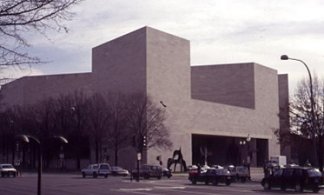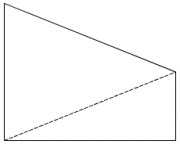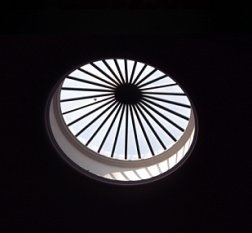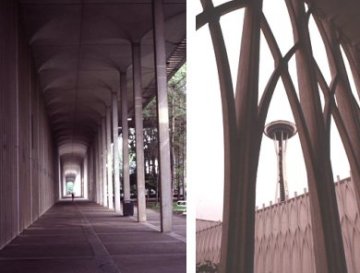Strolling down a city street or along a country road can provide a geometrical feast for the eye—when the viewing is done from a mathematical perspective.








“I see geometry in everything,” mathematician Thomas F. Banchoff of Brown University once remarked, as quoted in Keith Devlin’s book Life by the Numbers. “When I walk down the street, I’m always fascinated by some form. I love seeing patterns; I love looking up and looking at windows and ledges and seeing the way different objects fit together, especially if you position yourself in just the right way.”
I’ve spent many years wandering about, camera in hand, trying to capture some of these geometric wonders—both everyday sights and spectacular architectural feats.
In Washington, D.C., the National Gallery of Art’s East Building, which opened to the public in 1978, features a facade that teases the eye. Designed by architect I.M. Pei, the building is a festival of vast walls, sharp edges, and surprising shapes. Walls unexpectedly meet at acute and obtuse angles rather than commonplace right angles. Perspectives change dramatically as you walk around the building.
National Gallery of Art, East Building. |
In commenting on the inspiration for his East Building design, Pei noted in a 1978 article in National Geographic, “I sketched a trapezoid on the back of an envelope. I drew a diagonal line across the trapezoid and produced two triangles. That was the beginning.”
People react viscerally to the building, which was designed to fit on an oddly shaped plot of land. There’s one particularly sharp corner that has attracted a lot of attention. Over the years, so many people have felt the urge to touch the corner that the lavender-pink marble has developed a dark stain just below shoulder height where countless hands have deposited their oils.
A dark stain in the marble at a corner of the National Gallery’s East Building shows where countless hands have touched the surprisingly sharp edge. |
Across the mall beside the Hirshhorn Museum and Art Gallery stands another remarkable structure. Designed by Kenneth Snelson, this tapered framework of aluminum tubes and stainless-steel cables is an example of a tensegrity structure. The tubes aren’t connected to each other. Instead, a single, continuous cable threads through the tubes to hold the assemblage together in perfect balance. The tower rests on just three tubes, yet it’s strong enough to withstand severe storms.
Slim and graceful, Snelson’s Needle Tower delivers a delightful geometrical surprise when you venture underneath and look up to see a striking starlike pattern.
Kenneth Snelson’s Needle Tower, seen from the side and from underneath. |
In Charlottesville, Va., Thomas Jefferson’s Monticello and the University of Virginia have a variety of intriguing architectural and geometrical features. The university’s dome room, for example, has a magnificent skylight in the form of an elegantly segmented circle.
A skylight, designed by Thomas Jefferson, at the University of Virginia’s Rotunda. |
Indeed, looking up can present you with remarkable geometric vistas in a variety of settings. I still vividly recall how struck I was by the illusion of infinite extent on viewing a ceiling that consisted of stacked polygons of diminishing size in a building at Expo ’67 in Montreal.
A sequence of rotated polygons of diminishing size makes up the spectacular, soaring roof of the Man and His Community pavilion at Expo ’67 in Montreal. |
Visions of geometrical infinity abound in modern architectural design. The Albany campus of the State University of New York features an “academic podium” of 13 buildings on a common platform, all connected by a continuous roof and long colonnades. Designed by Edward Durrell Stone and completed in the mid-1960s, the campus complex is striking—and bewildering. In brilliant sunlight, its glaring whiteness and relentless symmetry make it difficult for visitors to navigate from place to place.
The colonnades and buildings (left) that make up the “academic podium” at the State University of New York at Albany can create a somewhat disorienting illusion of infinity, in contrast to the impression given by Seattle’s Space Needle (right) and its frame of soaring arches. |
Many years ago, when I was still in high school, I got my first broad view of mathematics from a beautifully illustrated book in the LIFE Science Library. One photograph from this book that has remained wedged in my mind is of the Kresge Auditorium at the Massachusetts Institute of Technology.
MIT’s Kresge Auditorium. |
The photo accompanied a discussion of integration (finding totals by stuffing curves with rectangles). The caption suggested that the nearly rectangular windows of the auditorium’s glass front filled the area under the curving roof, “architecturally illustrating the technique by which calculus finds the area under a curve.”
Ever since, I haven’t been able to look at a wall without, at some point, thinking of it as an integral between the curves defined by the ground and the roof.
And there’s a lot more to see when you survey the world around you with a mathematical eye.






